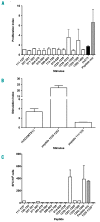The ADAMTS131239-1253 peptide is a dominant HLA-DR1-restricted CD4+ T-cell epitope
- PMID: 28751567
- PMCID: PMC5664387
- DOI: 10.3324/haematol.2015.136671
The ADAMTS131239-1253 peptide is a dominant HLA-DR1-restricted CD4+ T-cell epitope
Abstract
Acquired thrombotic thrombocytopenic purpura is a rare and severe disease characterized by auto-antibodies directed against "A Disintegrin And Metalloproteinase with Thrombospondin type 1 repeats, 13th member" (ADAMTS13), a plasma protein involved in hemostasis. Involvement of CD4+ T cells in the pathogenesis of the disease is suggested by the IgG isotype of the antibodies. However, the nature of the CD4+ T-cell epitopes remains poorly characterized. Here, we determined the HLA-DR-restricted CD4+ T-cell epitopes of ADAMTS13. Candidate T-cell epitopes were predicted in silico and binding affinities were confirmed in competitive enzyme-linked immunosorbent assays. ADAMTS13-reactive CD4+ T-cell hybridomas were generated following immunization of HLA-DR1 transgenic mice (Sure-L1 strain) and used to screen the candidate epitopes. We identified the ADAMTS131239-1253 peptide as the single immunodominant HLA-DR1-restricted CD4+ T-cell epitope. This peptide is located in the CUB2 domain of ADAMTS13. It was processed by dendritic cells, stimulated CD4+ T cells from Sure-L1 mice and was recognized by CD4+ T cells from an HLA-DR1-positive patient with acute thrombotic thrombocytopenic purpura. Interestingly, the ADAMTS131239-1253 peptide demonstrated promiscuity towards HLA-DR11 and HLA-DR15. Our work paves the way towards the characterization of the ADAMTS13-specific CD4+ T-cell response in patients with thrombotic thrombocytopenic purpura using ADAMTS131239-1253-loaded HLA-DR tetramers.
Copyright© Ferrata Storti Foundation.
Figures



References
-
- Furlan M, Robles R, Solenthaler M, et al. Acquired deficiency of von Willebrand factor-cleaving protease in a patient with thrombotic thrombocytopenic purpura. Blood. 1998;91(8):2839–2846. - PubMed
-
- Levy GG, Nichols WC, Lian EC, et al. Mutations in a member of the ADAMTS gene family cause thrombotic thrombocytopenic purpura. Nature. 2001;413(6855): 488–494. - PubMed
-
- Coppo P, Bengoufa D, Veyradier A, et al. Severe ADAMTS13 deficiency in adult idiopathic thrombotic microangiopathies defines a subset of patients characterized by various autoimmune manifestations, lower platelet count, and mild renal involvement. Medicine (Baltimore). 2004;83(4):233–244. - PubMed
Publication types
MeSH terms
Substances
LinkOut - more resources
Full Text Sources
Other Literature Sources
Research Materials

